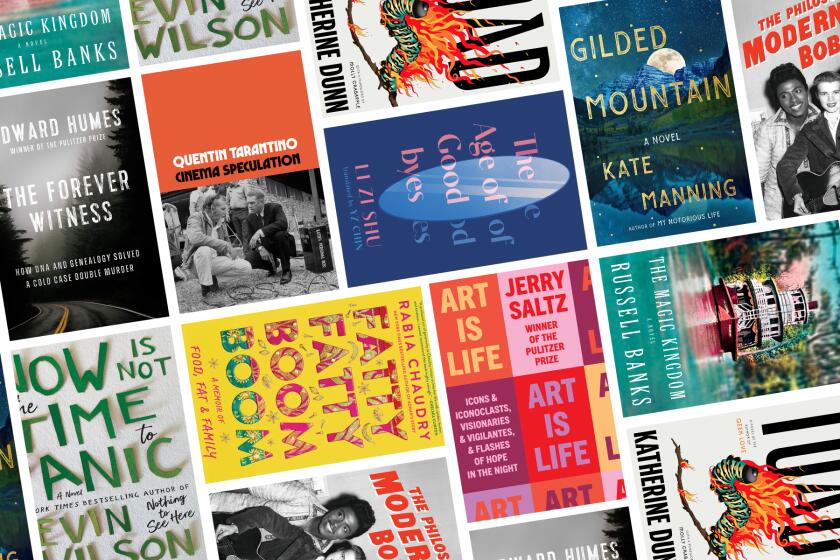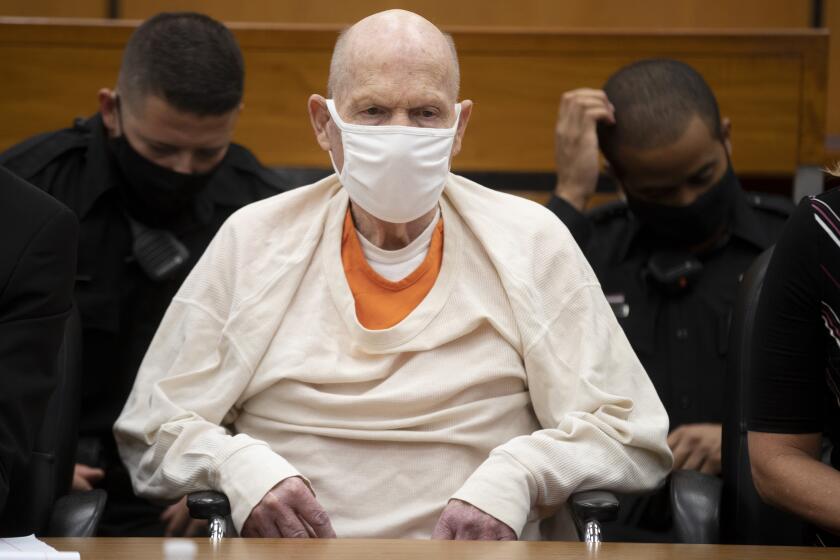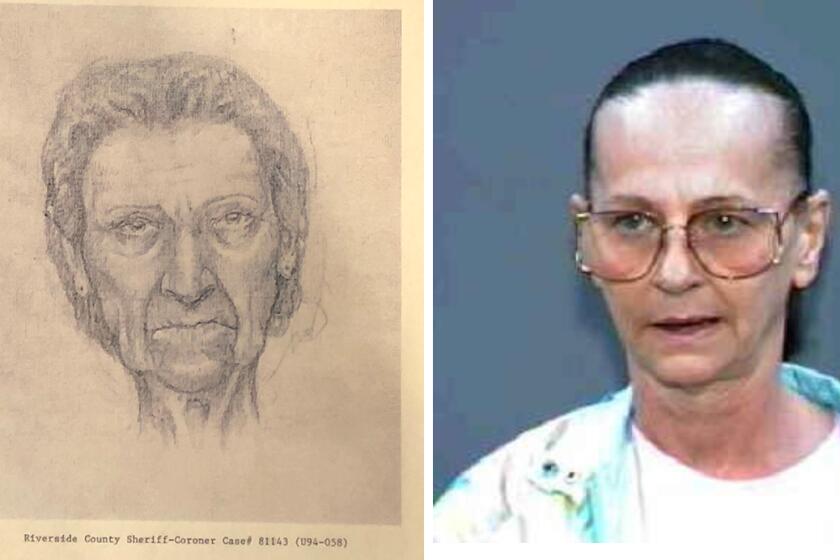DNA is solving cold cases everywhere. One true-crime writer thinks thatâs a tricky path

On the Shelf
The Forever Witness: How DNA and Genealogy Solved a Cold Case Double Murder
By Edward Humes
Dutton: 384 pages, $28
If you buy books linked on our site, The Times may earn a commission from Bookshop.org, whose fees support independent bookstores.
It was the coldest of cold cases. And then, when the time was right, an unassuming woman with no police experience solved it in an evening.
In 1987, a young Canadian couple, Jay Cook and Tanya Van Cuylenborg, headed toward Seattle for a quick trip mixing business and pleasure and never returned. Soon their bodies were found â in separate locations, dead of different causes. The killer disappeared into the mist of the Pacific Northwest.
Thirty years on, a relentless cold case detective, Jim Scharf, learned about the budding field of genetic genealogy and reached out to CeCe Moore, an expert in the field, who spent much of her time helping people piece together their family trees. (Genetic DNA matching was what had proved that Thomas Jefferson had fathered the children of his slave, Sally Hemings.)
Using the killerâs DNA from the crime scene, Moore reverse engineered both sides of a family tree until she found the connecting point; Scharf then collected DNA tossed from a truck by the suspect she named, proved it matched the crime scene, and, voila, case closed.
The first murder trial to utilize genetic genealogy caught the attention of Edward Humes, a Pulitzer Prize-winning journalist living in Seattle at the time.
âI was enthralled by the idea that this revolutionary means of identifying people and uncovering secrets was disdained at first by the forensic community,â he said during a recent phone call. âThis was developed by hobbyists working on family trees. Moore is a musical theater actress and former Barbie impersonator and she has now solved more cold cases than anyone.â
Humesâ previous book, âBurned,â eviscerated the use of junk science in criminal cases, mostly focusing on the arson âevidenceâ used to erroneously convict JoAnn Parks of murder after her children died in a 1989 L.A. County fire. (She was granted clemency just last year.)
Bethanne Patrickâs November highlights include musings from Dylan, Tarantino and Jerry Saltz, the returns of Russell Banks and Katherine Dunn and more.
This time around, as Humes explores in his latest book, âThe Forever Witness,â the science is solid and the potential is vast. Just before Moore solved the Seattle case, another pioneering researcher, Barbara Rae-Venter, used the technique to help police finally catch the Golden State Killer. But as Humes also notes in his book on the breakthrough, the use of genetic information raises hackles for some, who wonder about the potential for intrusions on privacy and police overreach.
The interview has been edited for length and clarity.
Beyond the crime itself, you write about how Moore finds results for people that shocked or dismayed them â the âthatâs not your real fatherâ kind of thing. Whatâs your feeling about ancestry searches?
It can trigger unforeseeable events when someone gives you a gift, âHey, I bought this on Amazon for you.â People have found out things that were really hurtful. I saw it at a genealogy conference where a woman in her 70s learned that her family wasnât what she thought it was. Itâs shockingly common and quite traumatic.
And one of those things may be â when a detective comes knocking on your door. âOh gee, my fourth cousin is a killer.â Itâs a true Pandoraâs box. Thereâs also the privacy issue. Youâre putting your DNA out in the universe.

Have you ever put your spit in a tube?
I have not. Iâm ambivalent â Iâm not sure the safeguards are there yet â but finding out about your roots is an alluring, powerful idea. If I do it, Iâll be going in with my eyes open. The juryâs out on me doing it, letâs just say that.
Barbara Rae-Venter has her own book coming in 2023. Is this an encouraging sign for expanding peopleâs understanding of the method?
Genetic genealogy has been reported on, but it often isnât really explained in the news coverage, and I think it makes peopleâs eyes glaze over. Books can ease people into understanding the science behind it while framing it in a human story. That will bring a lot more understanding.
Forty million people have done these DNA tests in the U.S. People donât think about the fact that you might be contributing to the discovery of a criminal in your own family, even if itâs somebody you donât know. Itâs something that should be part of the conversation. How should we feel about that? Should it be more closely regulated? These books can help stimulate that conversation.
Subscriber exclusive: Of the many mysteries that surround the Golden State Killer, one of the most consequential is exactly how authorities caught Joseph James DeAngelo Jr. four decades after his murders began.
Are the concerns about police using family trees legitimate or overblown?
The science is super-solid and itâs not just science â itâs old-school genealogy using documents and social media and other resources for the family-tree building.
But the bigger point is that nobody is arrested on the basis of a genetic genealogy finding. CeCe Moore reverse engineered the family tree from the DNA at the crime scene of the presumed killer, but they didnât go out and arrest the suspect. They acted like it was a tip someone phoned in. They investigated and got a DNA sample from a discarded coffee cup and used the tried-and-true method of DNA fingerprinting.
DNA has been the corrective to all the junk science since the 1980s â itâs just a fingerprint inside our cells. Thatâs the evidence used for probable cause to arrest and charge the killer.
Whatâs your position on the police collecting a personâs DNA without a warrant as they did here?
The argument goes that DNA is special because it contains so much information, so you should need a warrant. But thereâs a lot of conflating of problems and some of the critiques feel disingenuous.
If the police hacked into one of these ancestry databases, that would be a problem. Then they are getting genomic information on the characteristics of a person and thatâs your most secret and private information. Your credit card gets hacked, you get a new credit card. You cannot get a new DNA code.
But the police arenât doing that.
Is there a need for regulation in terms of what these DNA companies can and should share with police or other citizens?
You donât want to handcuff the police when thereâs something that can potentially save peopleâs lives, but thereâs not a lot of oversight now. Only three states have regulations, but mostly there are no limits. Maryland had a pretty good model as a good starting point for others.
Patricia Cavallaro was found partially buried nearly 30 years ago. Investigators identified her by finding a DNA match with a biological child.
Whatâs also problematic is these databases are all in private hands. The national fingerprint database is controlled by the U.S. Justice Department, and itâs not a for-profit enterprise.
Iâm not taking a position, but itâs odd to have this key forensic database in private, unregulated hands. It should be part of the discussion of how we move forward. There are issues with DNA, where people can pick up something of yours and sell your DNA information to insurers or lenders or potential employers. It can be a tool for espionage or blackmail. Thatâs what people should be afraid of. I see private bad actors being more likely to do that at this point. It will be interesting to see how that evolves. I donât think the subject gets the attention it needs. So if these books bring more brain power to the possible risks, that would be great.
More to Read
Sign up for our Book Club newsletter
Get the latest news, events and more from the Los Angeles Times Book Club, and help us get L.A. reading and talking.
You may occasionally receive promotional content from the Los Angeles Times.











